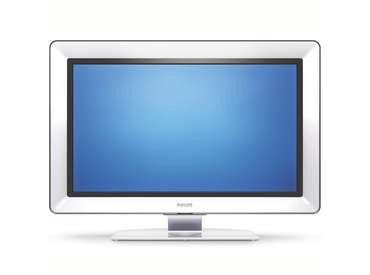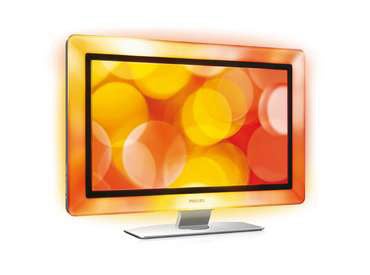Philips Aurea 42PFL9900D 42in LCD TV Review
Philips Aurea 42PFL9900D 42in LCD TV
The latest TV from Philips may be hideously expensive, but you ain't seen nothing like it!

Verdict
Key Specifications
- Review Price: £2859.00
Apparently, when the good Lord said ‘Let there be light’, he was talking directly to Philips. For with its new 42PFL9900D TV the brand has finally got tired of being ‘subtle’ with its still exclusive ‘Ambilight’ TV technology, and has instead gone what can only be described as gonzo with it. The results, as we’re about to find, are little short of extraordinary.
The best place to start is with a little backgrounder on Ambilight. At its core it’s a system whereby TVs emit lights from their edges which can be coloured to match the content of the image being shown.
Obviously this helps Ambilight TVs achieve a very distinctive style, but this wasn’t the main inspiration behind Philips developing the technology. Rather it was independent scientific research showing that people found long-term viewing of TVs more enjoyable and relaxing if the images on the screen were accompanied by some sort of light ‘context’ existing beyond the screen’s boundaries.
Initially Ambilight delivered just one colour simultaneously from the left and right edges of the TV. Then Philips developed a ‘stereo’ version that could do different colours from either side of the TV depending on the demands of the image content. And ultimately it launched a few TVs that delivered an Ambilight ‘Surround’ effect, where soothing light pooled from all four of the TV’s edges.
The key thing about all these Ambilight developments, though, was that the light was always produced from the rear of the TV, so that it pooled across the wall. With the Ambilight Spectra system on Philips’ so-called ‘Aurea’ 42PFL9900D TV, however, the light actually radiates forward from the entire TV bezel in what Philips likes to call a ‘Light Frame Effect’.
What’s more, Philips has now refined the processing behind the system to the extent that it can deliver different colours at multiple points around the bezel – all beautifully blended in so as not to look jarring – to increase the immersive accuracy of the Ambilight effect.
As you might expect from all this, the first Aurea TV is a remarkably striking unit to look at. In standby its bezel is a neutral white colour, but as soon as you switch it on it erupts into a blaze of coloured glory the like of which has simply never been seen round a TV before.
It’s utterly unique from a design perspective, and a guaranteed talking point at any dinner party. It came as no surprise, either, to find ITV’s This Morning adopting one as its main studio screen as soon as it could get its hands on one.
We should definitely add here, though, that just because it’s striking doesn’t mean that you’ll necessarily fall for it. During its time in our test facilities, while most people reacted to its looks very positively, it has to be said that those who disliked it did so intensely. You have been warned.
Before finding out how Ambilight Spectra/Light Frame affects your viewing experience, you might be surprised to find that the 42PFL9900D has plenty of other intriguing features up its sleeve.
For starters, the full HD 42in LCD panel is driven by Philips’ new Pixel Perfect HD processing engine. This uses as its foundation Pixel Plus 3 HD, with its advanced noise reduction, detail enhancement and colour improvements. But it ups the processing power, and slips in a host of new ingredients.
The first of these is HD Natural Motion, which claims a big improvement on Philips’ previous (definitely flawed) Digital Natural Motion system for removing stutter and judder from motion across the screen. The new HD Natural motion system also has an element which converts 24fps signals to 48Hz for a simple, clean 2:2 pulldown process.
Perfect Pixel HD also incorporates a new colour booster circuit that ups saturation levels and, courtesy of 14-bit processing, generates a claimed palette of four trillion colours.
Last but not least is a new 100Hz processing element which doubles the TV’s standard scanning rate to reduce LCD’s problems with retaining clarity with moving objects.
As if all this wasn’t enough, the 42PFL9900D sports Philips’ innovative Clear LCD technology, which uses a CRT-like scanning backlight system (as opposed to LCD’s usual single, static backlight) to boost response times and black levels.
There are some interesting bits and bobs in the 42PFL9900D’s connections, too. The three HDMIs, for instance, are all built to the latest v1.3 specification, and can take 1080p/24fps signals from suitably featured HD disc players. Plus you get a USB port able to directly play JPEG, MP3, and .alb slideshows, and a digital audio output for passing on digital bitstreams received via the HDMIs.
But that’s quite enough of that. Let’s finally get into finding out if Ambilight Spectra and Light Frame are just genius marketing ploys or things that genuinely enhance your viewing experience.
The first thing that has to be said is that the sophistication of the Aurea’s Ambilight technology is genuinely quite amazing. The lighting effects around the bezel really do marry up with specific, local bits of the picture content with remarkably accuracy, and provided you don’t select the rather jarring ‘dynamic’ Ambilight option, the various hues on show in the Light Frame also blend into each other quite beautifully, creating a much more mellow effect than we’d imagined would be possible from such an innately ‘in your face’ technology.
The colour palette available to the Aurea Ambilight system, meanwhile, is surprisingly subtle and varied, presumably thanks to Philips moving to LED rather than fluorescent tube light sources for its latest Ambilight generation.
In fact, it suddenly occurred to us that we’d got so lost in admiring Ambilight Spectra and the Light Frame for their sheer in your face cleverness that we’d kind of forgotten to actually watch the film (Bladerunner on Blu-ray, as it happens) that the Ambilight processing was working with. And herein lies a possible problem: the Light Frame might just be too distracting for some people to ever feel completely comfortable with, especially if the limitations of their viewing room means they have to sit rather close to the screen.
However, before deciding after a 10 minute test drive that Ambilight is probably just going to give you a headache, we urge you to do two things.
First, make sure that the Ambilight brightness setting is reduced to certainly no higher than four out of 10, and possibly as low as two. For only at this sort of gentle intensity does the effect seem to organically enhance rather than distract from the screen’s images. (It also has to be said that at lower brightness levels you’re less likely to be disturbed by the slightly ugly Philips logo that stands out so boldly from its back-lit bezel.)
The second thing we urge you to do if you’re not taking to the Aurea TV during a trial run is to give it more time. For it’s a simple fact that the longer we lived with the Aurea, the less we stared obsessively at the lit bezel and the more we just started to soak up the overall visual experience – screen and bezel. In fact, after a couple of days our suspicions had more or less completely evaporated, leaving us actively embracing the Aurea effect as something that genuinely adds to the sensory experience of watching a film.
By the time we had to let the 42PFL9900D go, our only serious gripe with the Light Frame system was its performance with letterboxed programmes, such as films shown with an aspect ratio wider than the TV’s native 16:9. Unfortunately the TV’s Ambilight processors read the edge of the image to see how the lighting sources should react, so if there’s a black bar there, the lights on the bezel next to those bars are left continually dull and thus distractingly at odds with the frenetic colour action taking place on the sides of the TV where the picture goes right to the edge.
Thankfully, though, Philips agrees that this is a problem, and has issued a firmware fix that reads colour information deeper into the picture when you’re watching letterboxed material. This firmware update is now being applied on the 42PFL9900D production lines, so you shouldn’t have to worry about it. But if you do happen to get your hands on a sample that came out before the firmware update was introduced, call 0800 7445477 to find out what you should do.
Of course, all this Ambilight Spectra/Light Frame fanciness would be no more than sheep’s clothing if the 42PFL9900’s pictures turned out to be wolfishly bad. But they’re not.
On the contrary, they’re quite possibly the finest pictures yet witnessed on a large LCD TV. Detail levels, for instance, are truly intense, producing a near-3D solidity to HD footage, but also holding up remarkably well with standard definition sources (thank you, Perfect Pixel HD).
Colours are emphatically vibrant and rich, while also enjoying terrifically natural tones by LCD standards. Helping to make this possible, meanwhile, are some really impressive black levels which, though still not as deep and rich as those found on good plasma TVs, are certainly among the very best we’ve seen on an LCD TV.
Still more goodness comes from the 42PFL9900D’s class-leading handling of motion, as the triple combi of HD Natural Motion, 100Hz processing and the Clear LCD backlighting system leaves objects passing across the screen more smoothly and clearly than on any other LCD TV we can think of.
Perhaps the single most remarkable thing about the 42PFL9900D’s pictures, though, is the fact that the huge amount of processing that goes into making them possible seems to do its thing in ‘real time’ with nary a hint of any unwanted processing side effects like smearing or dot crawl. Result!
You might think from looking at the 42PFL9900D’s colourful bezel that Philips has forgotten to include speakers. But in fact, not only are they hidden away in there somewhere, but they actually sound pretty good, with solid levels of bass handling, a rich mid-range and more treble clarity than is customary. We experienced one or two minor moments of lip synch trouble, perhaps caused by the image processing slightly delaying the video signal, but such moments are far too rare to prove irritating. Though we guess such AV synch issues might cause die-hard console gamers the odd ‘issue’…
”’Verdict”’
In wrapping this review up we’re clearly bound to point out that at the best part of three grand, the 42PFL9900D is prohibitively if not grotesquely expensive for a 42in flat TV. But then the 42PFL9900D is no ordinary 42in TV, as its dazzling if divisive design and matchless feature count make it more like something we’d expect to see from B&O than a mainstream brand.
In the end, since we’re not your bank manager, all we can do is tell you that a) the Ambilight Spectra/Light Frame system found on this Aurea TV works really well once you’ve ‘tamed’ it and got used to it, and b) the TV also happens to produce mind-bogglingly good picture quality. And these two reasons are more than enough to warrant us making the 42PFL9900D very much a Recommended product no matter how much it costs.
How we test televisions
We test every TV we review thoroughly over an extended period of time. We use industry standard tests to compare features properly. We’ll always tell you what we find. We never, ever, accept money to review a product.
Trusted Score
Score in detail
-
Value 7
-
Image Quality 10
-
Sound Quality 8

